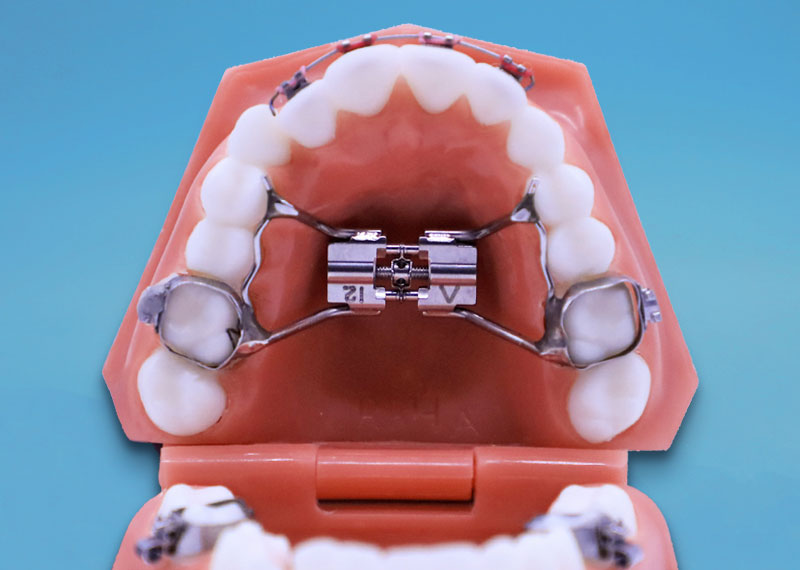
This special appliance is designed to widen the roof of your mouth by gently separating the suture in the center of your palate. The suture is similar to the soft spots on a baby’s head and will eventually fill in with bone as well. This expansion is easier and more effective at earlier ages, before the suture has fused. Expansion is performed when the upper jaw is too narrow relative to the lower jaw, or when the upper teeth are crowded or blocked out of the dental arch.
There are two types of expanders, and both use a key to widen the palate gradually. Both appliances transmit the force of expansion through the teeth to the underlying bony support.


The activation (or widening) schedule of the expander is dependent on each individual case, so please activate as directed. Usually, the expander screw is turned 1 time per day (typically at bedtime) for 4 to 6 weeks. You will visit our office regularly while activating your appliance so we can monitor your progress. If the next appointment is missed, do not continue turning the appliance until your progress is evaluated. In that case, please call the office promptly to reschedule.
• The patient should lie on a flat surface, such as a bed. It is helpful if there is a source of light available, such as a reading light so that the inside of the mouth can be illuminated.
• Firmly grip the RPE key. The metal tip will rotate about the end of the plastic handle. This provides the needed mobility for activation.
• Insert the key carefully into the hole in the middle front part of your appliance.
• Push the key gently and steadily from the front toward the back of your mouth. Remove the key angled towards your throat without backing up. Pushing the key back as far as possible brings forward a new keyhole position. Make certain that you have finished the turn, or you will not be able to find the next hole at the time of your next turn. You are now ready for the next activation!
During and immediately following the activation of the appliance, you may sense some initial discomfort and pressure, causing a tingling or “itch” under your expander. The pressure experienced can be near the bridge of the nose, in the region of the cheeks, or between the front teeth.
The first day or two is the breaking-in period and will be the most challenging. Initially, the patient may feel frustrated. We have found that with patience, encouragement, and a positive attitude, the patient will quickly adapt.
The following are some helpful ideas that will ease this adjustment period.
• Some tooth tenderness is normal and can be relieved by taking ibuprofen (Advil, Motrin) or Tylenol.
• Speech and eating difficulties usually are resolved within 24 - 72 hours. A helpful tip is to read aloud for a few days until speech improves.
• Eat softer foods for the first meal or two until you get accustomed to the device. Initially, cold treats such as ice cream or Popsicles may relieve uncomfortable symptoms. This should not become a habit due to the high sugar content. We recommend eating nutritious dishes like pasta, soup, cereal, apple sauce and yogurt. Within a few days, the patient should be able to eat almost anything on the "Orthodontic Diet List".
• During meals, food may accumulate between the roof of the mouth and the appliance. It is best to finish the meal or snack first, then dislodge the food by swishing around a mouthful of your drink. It is important to use the "swish and swallow" method. Trying to suck the material from the appliance could cause food particles to become lodged in the lungs and lead to a serious lung infection.
After about one week of activation, a space usually opens between the two upper front teeth. The appearance of the space is an excellent indication that treatment is progressing as expected. The space will continue to increase with subsequent activations. Occasionally, these front teeth will become slightly mobile and sensitive. This will subside within a short period of time. Discomfort can be relieved by taking ibuprofen (Advil, Motrin) or Tylenol. If the appliance becomes loose, or if there is pain or extreme breath odor, call the office immediately. If you think that the appliance feels loose, even though not visibly, then you should be seen within a few days.
After activation of the appliance has been discontinued, there will be a gradual closure of the midline dental spacing spontaneously. The upper front teeth will tend to drift and tip together. This closure of the space is to be expected and is NOT a sign that the expansion is relapsing.
It is very important that the space between the appliance and the roof of the mouth be cleansed thoroughly each day. Some people have found a Waterpik to be helpful if additional help is needed. If food particles remain under the appliance, they may become a source of irritation to the roof of the mouth, which will become uncomfortable for the patient. In extreme circumstances, infections may result.
Remember when brushing your teeth, pay particular attention to the margin where the appliance meets the gums on the cheek side and palate side. Improper brushing can leave a heavy plaque buildup, which will cause gingivitis. This can be eliminated within 2 - 4 days with adequate plaque removal while brushing.